Assessment of Land Use Land Cover Changes and Future Predictions Using CA-ANN Simulation for Selangor, Malaysia
Abstract
:1. Introduction
2. Materials and Methods
2.1. Study Area
2.2. Data Collection and Processing
2.3. Land Use Classification and Accuracy Assessment
2.4. Cellular Automata-Artificial Neural Network Simulation
3. Results and Discussion
3.1. Land Use and Land Cover Changes in Selangor from 1991 to 2021
3.2. Accuracy Assessment of LULC Maps
3.3. Transition Potential Modelling and Validation
3.4. LULC Maps for the Predicted Years of 2031, 2041, and 2051
4. Conclusions
Author Contributions
Funding
Institutional Review Board Statement
Informed Consent Statement
Data Availability Statement
Acknowledgments
Conflicts of Interest
References
- Houghton, R.A. The worldwide extent of land-use change. BioScience 1994, 44, 305–313. [Google Scholar] [CrossRef]
- Hathout, S. The use of GIS for monitoring and predicting urban growth in East and West St Paul, Winnipeg, Manitoba, Canada. J. Environ. Manag. 2002, 66, 229–238. [Google Scholar] [CrossRef]
- Fei, L.; Shuwen, Z.; Jiuchun, Y.; Liping, C.; Haijuan, Y.; Kun, B. Effects of land use change on ecosystem services value in West Jilin since the reform and opening of China. Ecosyst. Serv. 2018, 31, 12–20. [Google Scholar] [CrossRef]
- López, E.; Bocco, G.; Mendoza, M.; Duhau, E. Predicting land-cover and land-use change in the urban fringe: A case in Morelia city, Mexico. Landsc. Urban Plan. 2001, 55, 271–285. [Google Scholar] [CrossRef]
- Jat, M.K.; Garg, P.K.; Khare, D. Monitoring and modelling of urban sprawl using remote sensing and GIS techniques. Int. J. Appl. Earth Obs. Geoinf. 2008, 10, 26–43. [Google Scholar] [CrossRef]
- Guerra, F.; Puig, H.; Chaume, R. The forest-savanna dynamics from multi-date Landsat-TM data in Sierra Parima, Venezuela. Int. J. Remote. Sens. 1998, 19, 2061–2075. [Google Scholar] [CrossRef]
- Lipczynska-Kochany, E. Effect of climate change on humic substances and associated impacts on the quality of surface water and groundwater: A review. Sci. Total. Environ. 2018, 640, 1548–1565. [Google Scholar] [CrossRef] [PubMed]
- Li, P.; Tian, R.; Xue, C.; Wu, J. Progress, opportunities, and key fields for groundwater quality research under the impacts of human activities in China with a special focus on western China. Environ. Sci. Pollut. Res. 2017, 24, 13224–13234. [Google Scholar] [CrossRef]
- Rekha, P.N.; Gangadharan, R.; Ravichandran, P.; Dharshini, S.; Clarke, W.; Pillai, S.; Panigrahi, A.; Ponniah, A. Land-use/land-cover change dynamics and groundwater quality in and around shrimp farming area in coastal watershed, Cuddalore district, Tamil Nadu, India. Curr. Sci. 2017, 113, 1763–1770. [Google Scholar] [CrossRef]
- Khan, R.; Jhariya, D. Assessment of land-use and land-cover change and its impact on groundwater quality using remote sensing and GIS techniques in Raipur City, Chhattisgarh, India. J. Geol. Soc. India 2018, 92, 59–66. [Google Scholar] [CrossRef]
- He, S.; Wu, J. Hydrogeochemical characteristics, groundwater quality, and health risks from hexavalent chromium and nitrate in groundwater of Huanhe Formation in Wuqi county, northwest China. Expo. Health 2019, 11, 125–137. [Google Scholar] [CrossRef]
- Sadeghi, A.; Galalizadeh, S.; Zehtabian, G.; Khosravi, H. Assessing the change of groundwater quality compared with land-use change and precipitation rate (Zrebar Lake’s Basin). Appl. Water Sci. 2021, 11, 1–15. [Google Scholar] [CrossRef]
- Singh, A. Review article digital change detection techniques using remotely-sensed data. Int. J. Remote. Sens. 1989, 10, 989–1003. [Google Scholar] [CrossRef] [Green Version]
- Lu, D.; Mausel, P.; Brondizio, E.; Moran, E. Change detection techniques. Int. J. Remote Sens. 2004, 25, 2365–2401. [Google Scholar] [CrossRef]
- Roy, A.; Inamdar, A.B. Multi-temporal Land Use Land Cover (LULC) change analysis of a dry semi-arid river basin in western India following a robust multi-sensor satellite image calibration strategy. Heliyon 2019, 5, e01478. [Google Scholar] [CrossRef] [Green Version]
- Helmer, E.H.; Brown, S.; Cohen, W. Mapping montane tropical forest successional stage and land use with multi-date Landsat imagery. Int. J. Remote Sens. 2000, 21, 2163–2183. [Google Scholar] [CrossRef]
- Hussain, M.; Chen, D.; Cheng, A.; Wei, H.; Stanley, D. Change detection from remotely sensed images: From pixel-based to object-based approaches. ISPRS J. Photogramm. Remote Sens. 2013, 80, 91–106. [Google Scholar] [CrossRef]
- Singh, Y.; Ferrazzoli, P.; Rahmoune, R. Flood monitoring using microwave passive remote sensing (AMSR-E) in part of the Brahmaputra basin, India. Int. J. Remote Sens. 2013, 34, 4967–4985. [Google Scholar] [CrossRef]
- Alexakis, D.; Agapiou, A.; Tzouvaras, M.; Themistocleous, K.; Neocleous, K.; Michaelides, S.; Hadjimitsis, D.G. Integrated use of GIS and remote sensing for monitoring landslides in transportation pavements: The case study of Paphos area in Cyprus. Nat. Hazards 2014, 72, 119–141. [Google Scholar] [CrossRef]
- Yiridomoh, G.Y.; Appiah, D.O.; Owusu, V.; Bonye, S.Z. Women smallholder farmers off-farm adaptation strategies to climate variability in rural savannah, Ghana. GeoJournal 2021, 86, 2367–2385. [Google Scholar] [CrossRef]
- Vibhute, A.D.; Gawali, B.W. Analysis and modeling of agricultural land use using remote sensing and geographic information system: A review. Int. J. Eng. Res. Appl. 2013, 3, 081–091. [Google Scholar]
- Jiang, X.; Lu, D.; Moran, E.; Calvi, M.F.; Dutra, L.V.; Li, G. Examining impacts of the Belo Monte hydroelectric dam construction on land-cover changes using multitemporal Landsat imagery. Appl. Geogr. 2018, 97, 35–47. [Google Scholar] [CrossRef]
- Hazarika, N.; Das, A.K.; Borah, S.B. Assessing land-use changes driven by river dynamics in chronically flood affected Upper Brahmaputra plains, India, using RS-GIS techniques. Egypt. J. Remote Sens. Space Sci. 2015, 18, 107–118. [Google Scholar] [CrossRef] [Green Version]
- Iqbal, M.F.; Khan, I.A. Spatiotemporal land use land cover change analysis and erosion risk mapping of Azad Jammu and Kashmir, Pakistan. Egypt. J. Remote Sens. Space Sci. 2014, 17, 209–229. [Google Scholar] [CrossRef] [Green Version]
- Mohamed, M.A. Monitoring of temporal and spatial changes of land use and land cover in metropolitan regions through remote sensing and GIS. Nat. Resour. 2017, 08, 353–369. [Google Scholar] [CrossRef] [Green Version]
- El Gammal, E.A.; Salem, S.M.; El Gammal, A.E.A. Change detection studies on the world’s biggest artificial lake (Lake Nasser, Egypt). Egypt. J. Remote Sens. Space Sci. 2010, 13, 89–99. [Google Scholar] [CrossRef] [Green Version]
- Akinyemi, F.O. Land change in the central Albertine rift: Insights from analysis and mapping of land use-land cover change in north-western Rwanda. Appl. Geogr. 2017, 87, 127–138. [Google Scholar] [CrossRef]
- Zeshan, M.T.; Mustafa, M.R.U.; Baig, M.F. Monitoring Land Use Changes and Their Future Prospects Using GIS and ANN-CA for Perak River Basin, Malaysia. Water 2021, 13, 2286. [Google Scholar] [CrossRef]
- Mohammadi, A.; Shahabi, H.; Bin Ahmad, B. Land-Cover Change Detection in a Part of Cameron Highlands, Malaysia Using ETM+ Satellite Imagery and Support Vector Machine (SVM) Algorithm. EnvironmentAsia 2019, 12, 2. [Google Scholar]
- Al-Najjar, H.A.; Kalantar, B.; Pradhan, B.; Saeidi, V.; Halin, A.A.; Ueda, N.; Mansor, S. Land cover classification from fused DSM and UAV images using convolutional neural networks. Remote Sens. 2019, 11, 1461. [Google Scholar] [CrossRef] [Green Version]
- Seto, K.; Kaufmann, R. Using logit models to classify land cover and land-cover change from Landsat Thematic Mapper. Int. J. Remote. Sens. 2005, 26, 563–577. [Google Scholar] [CrossRef]
- Richards, J.A.; Jia, X. Image classification methodologies. Remote Sens. Digit. Image Anal. Introd. 2006, 295–332. Available online: https://scholar.google.com.hk/scholar?q=Image+classification+methodologies&hl=zh-CN&as_sdt=0&as_vis=1&oi=scholart (accessed on 10 November 2021).
- Srivastava, P.K.; Han, D.; Rico-Ramirez, M.A.; Bray, M.; Islam, T. Selection of classification techniques for land use/land cover change investigation. Adv. Space Res. 2012, 50, 1250–1265. [Google Scholar] [CrossRef]
- Cortes, C.; Vapnik, V. Support-vector networks. Mach. Learn. 1995, 20, 273–297. [Google Scholar] [CrossRef]
- Vapnik, V. Statistical learning theory new york. NY Wiley 1998, 1, 2. [Google Scholar]
- Talukdar, S.; Singha, P.; Mahato, S.; Praveen, B.; Rahman, A. Dynamics of ecosystem services (ESs) in response to land use land cover (LU/LC) changes in the lower Gangetic plain of India. Ecol. Indic. 2020, 112, 106121. [Google Scholar] [CrossRef]
- Zhang, C.; Sargent, I.; Pan, X.; Li, H.; Gardiner, A.; Hare, J.; Atkinson, P.M. Joint Deep Learning for land cover and land use classification. Remote. Sens. Environ. 2019, 221, 173–187. [Google Scholar] [CrossRef] [Green Version]
- Pal, M. Random forest classifier for remote sensing classification. Int. J. Remote. Sens. 2005, 26, 217–222. [Google Scholar] [CrossRef]
- Civco, D.L. Artificial neural networks for land-cover classification and mapping. Int. J. Geogr. Inf. Sci. 1993, 7, 173–186. [Google Scholar] [CrossRef]
- Carranza-García, M.; García-Gutiérrez, J.; Riquelme, J.C. A framework for evaluating land use and land cover classification using convolutional neural networks. Remote Sens. 2019, 11, 274. [Google Scholar] [CrossRef] [Green Version]
- Ma, L.; Li, M.; Ma, X.; Cheng, L.; Du, P.; Liu, Y. A review of supervised object-based land-cover image classification. ISPRS J. Photogramm. Remote Sens. 2017, 130, 277–293. [Google Scholar] [CrossRef]
- Mountrakis, G.; Im, J.; Ogole, C. Support vector machines in remote sensing: A review. ISPRS J. Photogramm. Remote Sens. 2011, 66, 247–259. [Google Scholar] [CrossRef]
- Theobald, D.M.; Hobbs, N.T. Forecasting rural land-use change: A comparison of regression-and spatial transition-based models. Geogr. Environ. Model. 1998, 2, 65–82. [Google Scholar]
- Pocewicz, A.; Nielsen-Pincus, M.; Goldberg, C.; Johnson, M.; Morgan, P.; Force, J.; Waits, L.; Vierling, L. Predicting land use change: Comparison of models based on landowner surveys and historical land cover trends. Landsc. Ecol. 2008, 23, 195–210. [Google Scholar] [CrossRef]
- Lamchin, M.; Lee, W.-K.; Jeon, S.W.; Wang, S.W.; Lim, C.H.; Song, C.; Sung, M. Long-term trend and correlation between vegetation greenness and climate variables in Asia based on satellite data. Sci. Total. Environ. 2018, 618, 1089–1095. [Google Scholar] [CrossRef]
- Reza, M.I.H. Southeast Asian Landscapes Are Facing Rapid Transition: A Study in the State of Selangor, Peninsular Malaysia. Bull. Sci. Technol. Soc. 2016, 36, 118–127. [Google Scholar] [CrossRef]
- Abdullah, S.A.; Nakagoshi, N. Forest fragmentation and its correlation to human land use change in the state of Selangor, peninsular Malaysia. For. Ecol. Manag. 2007, 241, 39–48. [Google Scholar] [CrossRef]
- Gao, J.; Liu, Y. Determination of land degradation causes in Tongyu County, Northeast China via land cover change detection. Int. J. Appl. Earth Obs. Geoinf. 2010, 12, 9–16. [Google Scholar] [CrossRef]
- Shamsi, S.F. Integrating linear programming and analytical hierarchical processing in raster-GIS to optimize land use pattern at watershed level. J. Appl. Sci. Environ. Manag. 2010, 14, 2. [Google Scholar]
- Hyandye, C.; Mandara, C.G.; Safari, J. GIS and logit regression model applications in land use/land cover change and distribution in Usangu catchment. Am. J. Remote Sens. 2015, 3, 6–16. [Google Scholar] [CrossRef] [Green Version]
- Nedd, R.; Light, K.; Owens, M.; James, N.; Johnson, E.; Anandhi, A. A Synthesis of Land Use/Land Cover Studies: Definitions, Classification Systems, Meta-Studies, Challenges and Knowledge Gaps on a Global Landscape. Land 2021, 10, 994. [Google Scholar] [CrossRef]
- Congalton, R.; Green, K. Thematic accuracy. Assess. Accur. Remote Sens. Data Princ. Pr. 2009, 4, 55–61. [Google Scholar]
- Laliberte, A.S.; Rango, A.; Havstad, K.M.; Paris, J.F.; Beck, R.F.; McNeely, R.; Gonzalez, A.L. Object-oriented image analysis for mapping shrub encroachment from 1937 to 2003 in southern New Mexico. Remote Sens. Environ. 2004, 93, 198–210. [Google Scholar] [CrossRef]
- Rahman, M.T.U.; Tabassum, F.; Rasheduzzaman, M.; Saba, H.; Sarkar, L.; Ferdous, J.; Uddin, S.Z.; Islam, A.Z. Temporal dynamics of land use/land cover change and its prediction using CA-ANN model for southwestern coastal Bangladesh. Environ. Monit. Assess. 2017, 189, 1–18. [Google Scholar] [CrossRef] [PubMed]
- El-Tantawi, A.M.; Bao, A.; Chang, C.; Liu, Y. Monitoring and predicting land use/cover changes in the Aksu-Tarim River Basin, Xinjiang-China (1990–2030). Environ. Monit. Assess. 2019, 191, 1–18. [Google Scholar] [CrossRef]
- Memarian, H.; Balasundram, S.K.; Talib, J.B.; Sung, C.T.B.; Sood, A.M.; Abbaspour, K. Validation of CA-Markov for simulation of land use and cover change in the Langat Basin, Malaysia. J. Geogr. Inf. Syst. 2012, 04, 542–554. [Google Scholar] [CrossRef] [Green Version]
- Abbas, Z.; Yang, G.; Zhong, Y.; Zhao, Y. Spatiotemporal Change Analysis and Future Scenario of LULC Using the CA-ANN Approach: A Case Study of the Greater Bay Area, China. Land 2021, 10, 584. [Google Scholar] [CrossRef]
- Seto, K.C.; Kaufmann, R.K. Modeling the drivers of urban land use change in the Pearl River Delta, China: Integrating remote sensing with socioeconomic data. Land Econ. 2003, 79, 106–121. [Google Scholar] [CrossRef] [Green Version]
- Yin, J.; Yin, Z.; Zhong, H.; Xu, S.; Hu, X.; Wang, J.; Wu, J. Monitoring urban expansion and land use/land cover changes of Shanghai metropolitan area during the transitional economy (1979–2009) in China. Environ. Monit. Assess. 2011, 177, 609–621. [Google Scholar] [CrossRef]
- Guangjin, T.; Xinliang, X.; Xiaojuan, L.; Lingqiang, K. The comparison and modeling of the driving factors of urban expansion for thirty-five big cities in the three regions in China. Adv. Meteorol. 2016, 2016, 1–9. [Google Scholar] [CrossRef] [Green Version]
- Abdullah, J. City competitiveness and urban sprawl: Their implications to socio-economic and cultural life in Malaysian cities. Procedia-Soc. Behav. Sci. 2012, 50, 20–29. [Google Scholar] [CrossRef] [Green Version]
- Olaniyi, A.; Abdullah, A.; Ramli, M.; Sood, A. Agricultural land use in Malaysia: An historical overview and implications for food security. Bulg. J. Agric. Sci. 2013, 19, 60–69. [Google Scholar]
- Golam Hassan, A.A.; Ngah, I.; Applanaidu, S.D. Agricultural Transformation in Malaysia: The Role of Smallholders And Area Development. Development 2018, 15, 2. [Google Scholar]
- Yatoo, S.A.; Sahu, P.; Kalubarme, M.H.; Kansara, B.B. Monitoring land use changes and its future prospects using cellular automata simulation and artificial neural network for Ahmedabad city, India. GeoJournal 2020, 85, 1–22. [Google Scholar] [CrossRef]
- Wu, Q.; Li, H.-q.; Wang, R.-s.; Paulussen, J.; He, Y.; Wang, M.; Wang, B.-h.; Wang, Z. Monitoring and predicting land use change in Beijing using remote sensing and GIS. Landsc. Urban Plan. 2006, 78, 322–333. [Google Scholar] [CrossRef]
- Li, X.; Wang, Y.; Li, J.; Lei, B. Physical and Socioeconomic Driving Forces of Land-Use and Land-Cover Changes: A Case Study of Wuhan City, China. Discret. Dyn. Nat. Soc. 2016, 2016, 8061069. [Google Scholar] [CrossRef] [Green Version]
- Serneels, S.; Lambin, E.F. Proximate causes of land-use change in Narok District, Kenya: A spatial statistical model. Agric. Ecosyst. Environ. 2001, 85, 65–81. [Google Scholar] [CrossRef] [Green Version]
- Wu, R.; Li, Z.; Wang, S. The varying driving forces of urban land expansion in China: Insights from a spatial-temporal analysis. Sci. Total. Environ. 2021, 766, 142591. [Google Scholar] [CrossRef]
- Seto, K.C.; Güneralp, B.; Hutyra, L.R. Global forecasts of urban expansion to 2030 and direct impacts on biodiversity and carbon pools. Proc. Natl. Acad. Sci. USA 2012, 109, 16083–16088. [Google Scholar] [CrossRef] [PubMed] [Green Version]
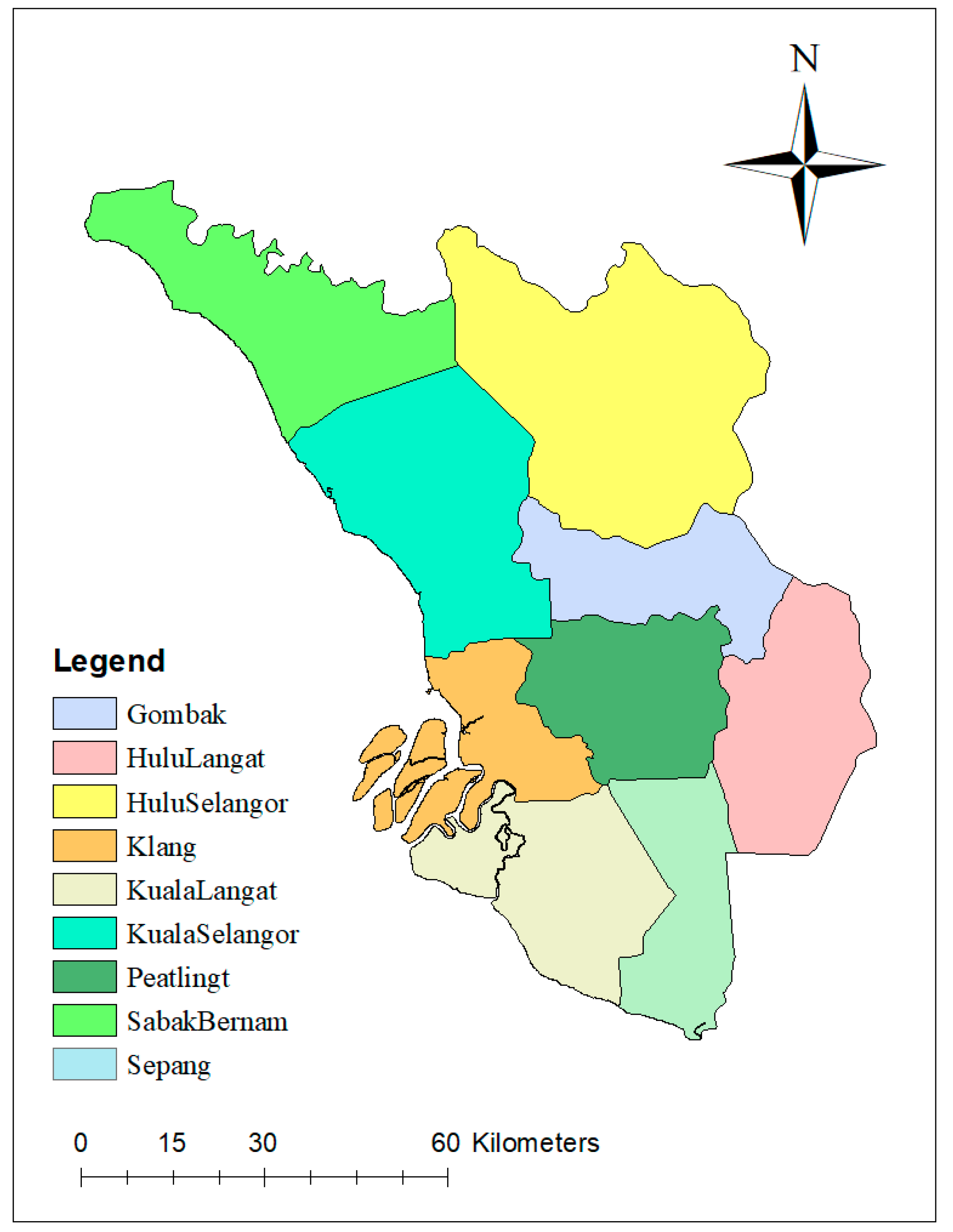
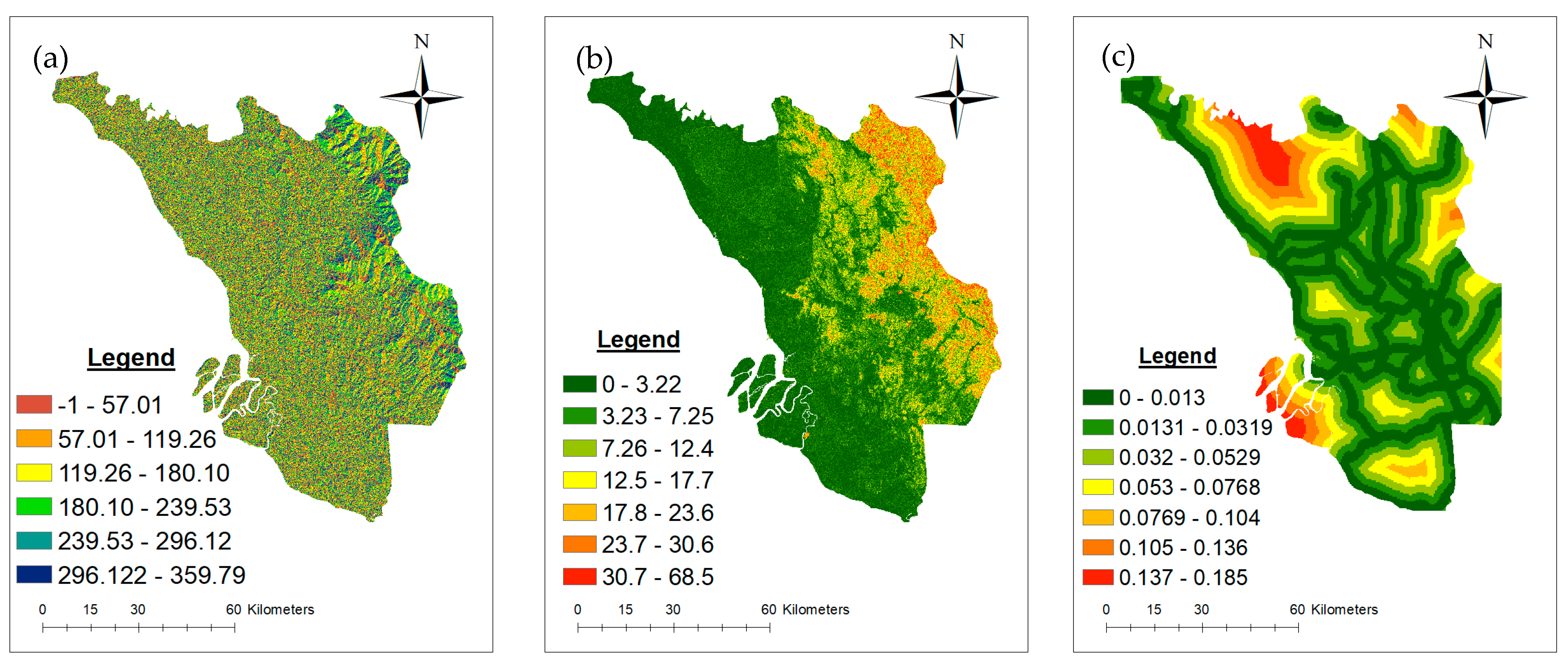
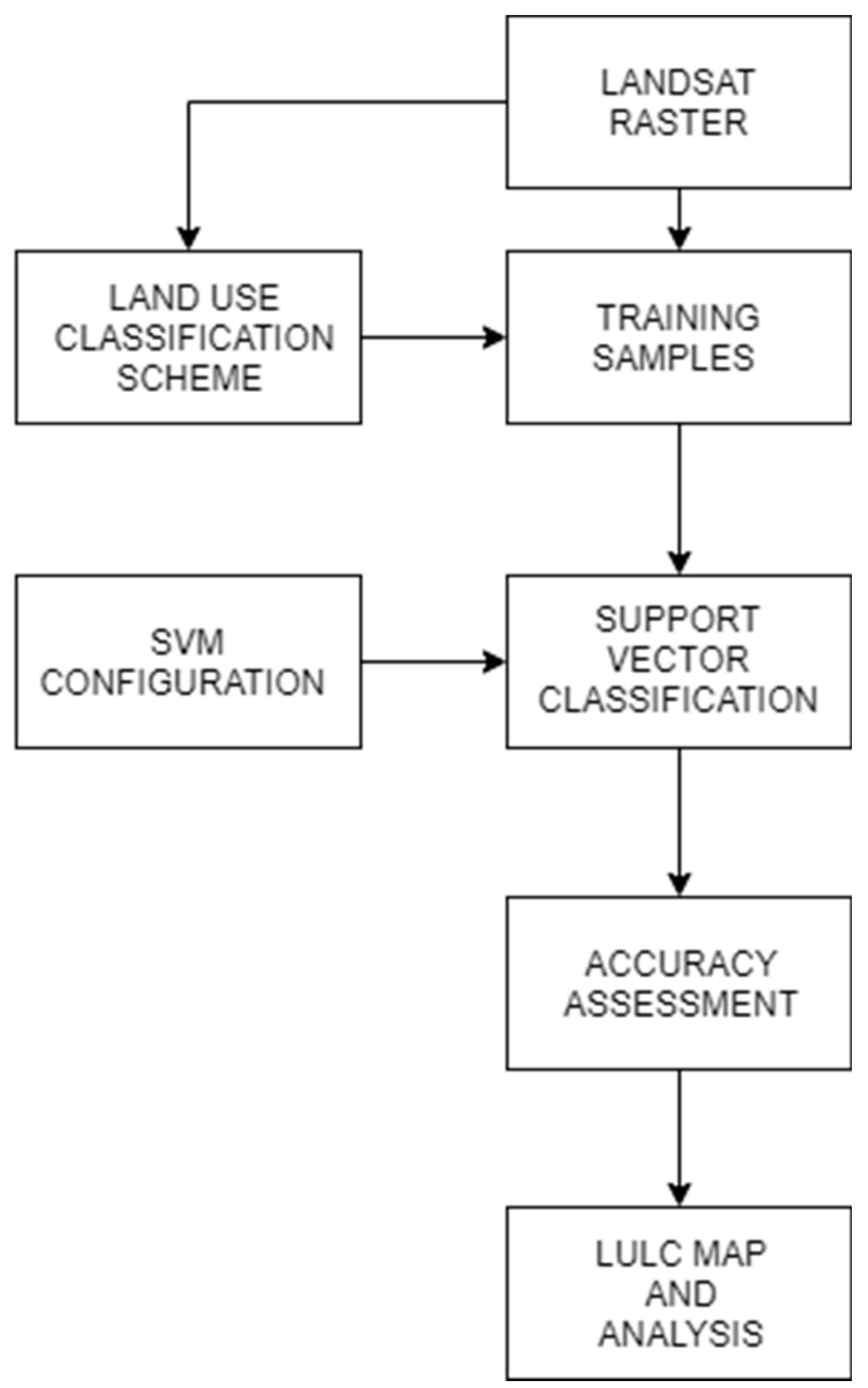



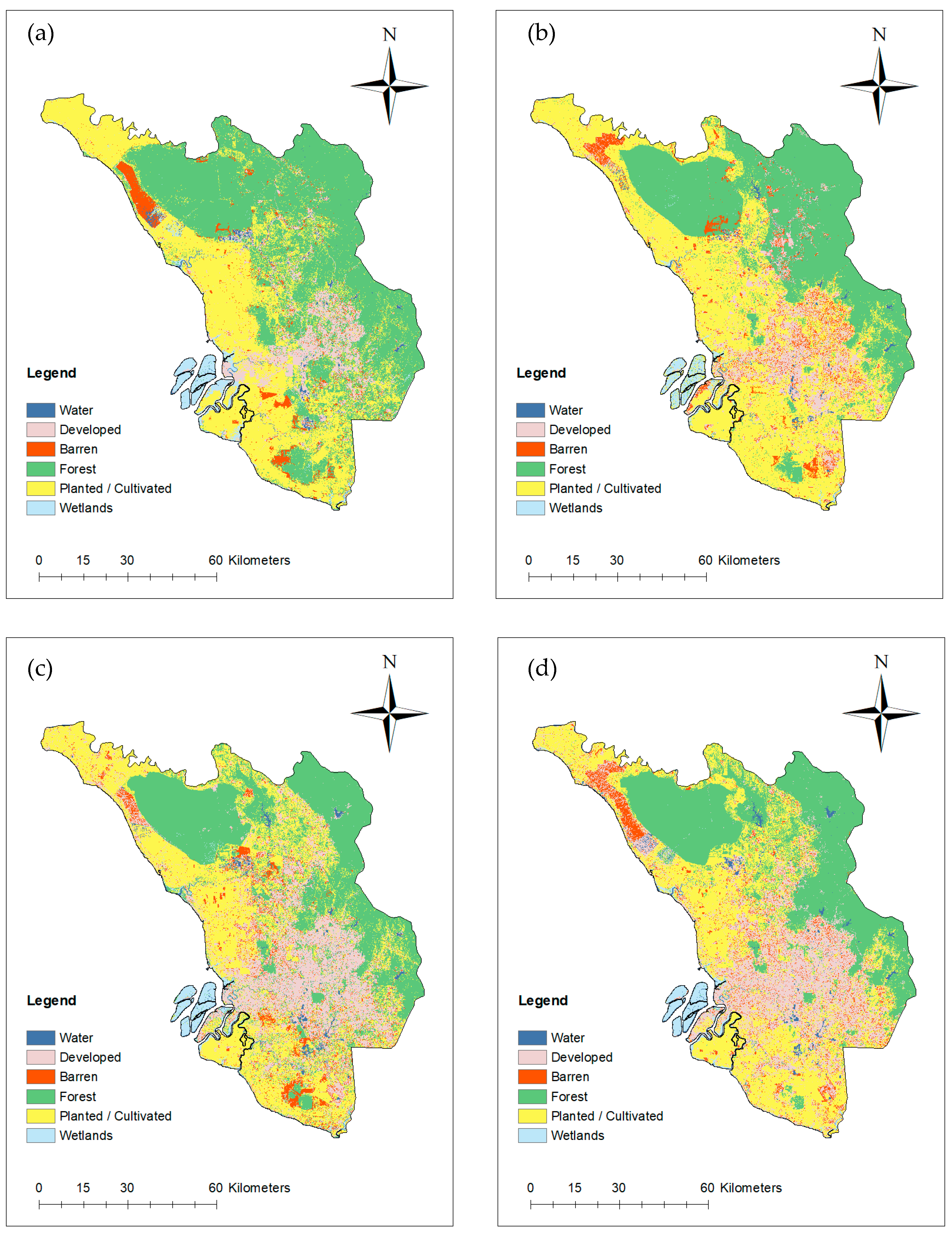

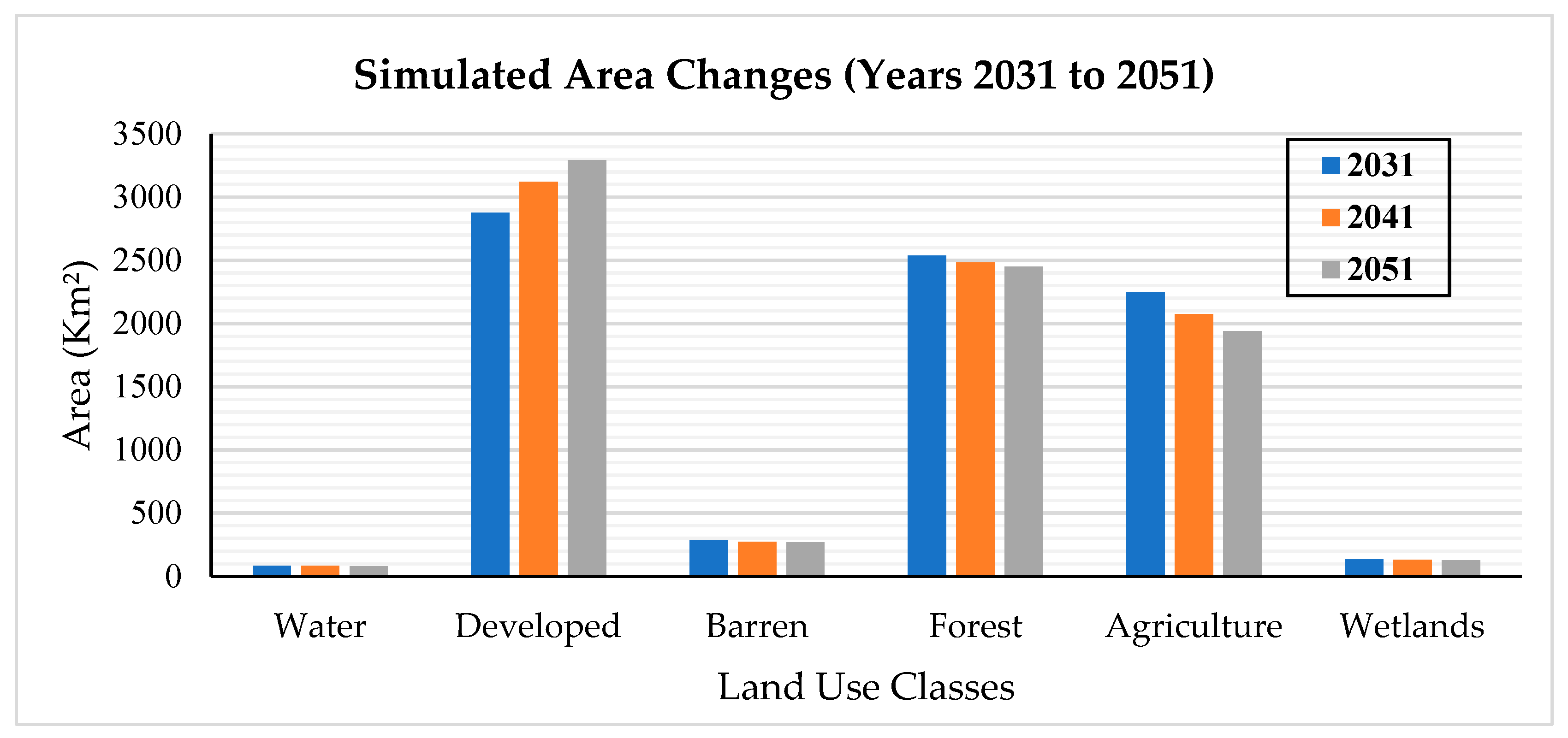
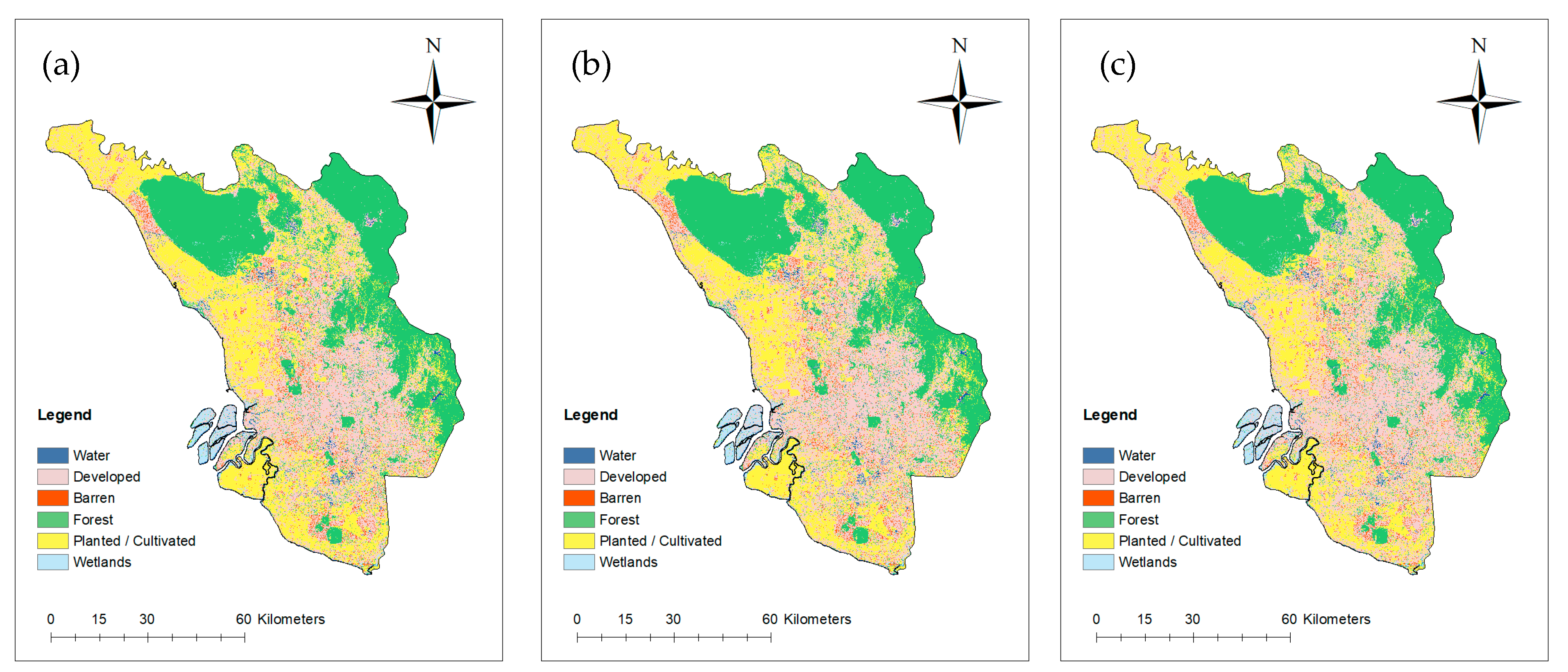
| Years | 1991 | 2001 | 2011 | 2021 | ||||
|---|---|---|---|---|---|---|---|---|
| LULC Classes | Area (Km2) | % | Area (Km2) | % | Area (Km2) | % | Area (Km2) | % |
| Water | 99.14 | 1.22 | 97.74 | 1.20 | 135.58 | 1.66 | 142.49 | 1.75 |
| Developed | 707.32 | 8.67 | 1003.50 | 12.30 | 1878.31 | 23.02 | 1974.95 | 24.21 |
| Barren | 342.11 | 4.19 | 486.02 | 5.96 | 490.97 | 6.02 | 501.40 | 6.15 |
| Forest | 3805.57 | 46.65 | 2985.31 | 36.59 | 2734.60 | 33.52 | 2662.41 | 32.64 |
| Agriculture | 2921.91 | 35.82 | 3416.77 | 41.88 | 2735.24 | 33.53 | 2671.36 | 32.75 |
| Wetlands | 281.95 | 3.46 | 168.66 | 2.07 | 183.29 | 2.25 | 205.40 | 2.52 |
| Periods | 1991–2001 | 2001–2011 | 2011–2021 |
|---|---|---|---|
| LULC Classes | Area (Km2) | Area (Km2) | Area (Km2) |
| Water | −1.40 | 37.84 | 6.90 |
| Developed | 296.19 | 874.81 | 96.64 |
| Barren | 143.90 | 4.95 | 10.43 |
| Forest | −820.26 | −250.70 | −72.20 |
| Agriculture | 494.86 | −681.52 | −63.88 |
| Wetlands | −113.29 | 14.62 | 22.11 |
| Accuracy Types | Year | 1991 | 2001 | 2011 | 2021 |
|---|---|---|---|---|---|
| LULC | % | % | % | % | |
| Producer Accuracy (%) | Water | 100.0 | 100.0 | 100.0 | 100.0 |
| Developed | 95.8 | 97.1 | 98.0 | 98.0 | |
| Barren | 77.8 | 80.0 | 58.3 | 81.8 | |
| Forest | 98.0 | 88.9 | 93.1 | 90.3 | |
| Agriculture | 97.9 | 98.0 | 97.6 | 94.6 | |
| Wetlands | 100.0 | 90.0 | 100.0 | 100.0 | |
| User Accuracy (%) | Water | 100.0 | 100.0 | 100.0 | 100.0 |
| Developed | 92.0 | 94.4 | 90.6 | 96.2 | |
| Barren | 87.5 | 88.9 | 87.5 | 90.0 | |
| Forest | 98.0 | 94.1 | 96.4 | 93.3 | |
| Agriculture | 97.9 | 94.1 | 95.3 | 92.1 | |
| Wetlands | 100.0 | 90.0 | 100.0 | 100.0 | |
| Overall Accuracy (%) | 96.7 | 94.0 | 94.0 | 94.7 | |
| Kappa Coefficient | 0.96 | 0.92 | 0.92 | 0.93 | |
| Year | 2011 | ||||||
|---|---|---|---|---|---|---|---|
| Category | Water | Developed | Barren | Forest | Agriculture | Wetlands | |
| 2001 | Water | 0.997 | 0.00118 | 0.00046 | 0.00061 | 0.0006 | 0.0002 |
| Developed | 0.017 | 0.731 | 0.086 | 0.054 | 0.1109 | 0.0015 | |
| Barren | 0.006 | 0.533 | 0.122 | 0.064 | 0.2737 | 0.0011 | |
| Forest | 0.002 | 0.050 | 0.024 | 0.748 | 0.1717 | 0.0040 | |
| Agriculture | 0.011 | 0.210 | 0.078 | 0.116 | 0.5740 | 0.0108 | |
| Wetlands | 0.015 | 0.045 | 0.009 | 0.075 | 0.0802 | 0.7751 | |
| Years | 2031 | 2041 | 2051 | |||
|---|---|---|---|---|---|---|
| LULC Classes | Area (Km2) | % | Area (Km2) | % | Area (Km2) | % |
| Water | 85.14 | 1.04 | 82.66 | 1.01 | 81.80 | 1.00 |
| Developed | 2874.31 | 35.23 | 3118.96 | 38.23 | 3292.40 | 40.36 |
| Barren | 284.25 | 3.48 | 272.03 | 3.33 | 266.75 | 3.27 |
| Forest | 2536.46 | 31.09 | 2482.07 | 30.42 | 2447.83 | 30.01 |
| Agriculture | 2244.04 | 27.51 | 2071.81 | 25.40 | 1940.11 | 23.78 |
| Wetlands | 133.80 | 1.64 | 130.48 | 1.60 | 129.11 | 1.58 |
Publisher’s Note: MDPI stays neutral with regard to jurisdictional claims in published maps and institutional affiliations. |
© 2022 by the authors. Licensee MDPI, Basel, Switzerland. This article is an open access article distributed under the terms and conditions of the Creative Commons Attribution (CC BY) license (https://creativecommons.org/licenses/by/4.0/).
Share and Cite
Baig, M.F.; Mustafa, M.R.U.; Baig, I.; Takaijudin, H.B.; Zeshan, M.T. Assessment of Land Use Land Cover Changes and Future Predictions Using CA-ANN Simulation for Selangor, Malaysia. Water 2022, 14, 402. https://doi.org/10.3390/w14030402
Baig MF, Mustafa MRU, Baig I, Takaijudin HB, Zeshan MT. Assessment of Land Use Land Cover Changes and Future Predictions Using CA-ANN Simulation for Selangor, Malaysia. Water. 2022; 14(3):402. https://doi.org/10.3390/w14030402
Chicago/Turabian StyleBaig, Mohammed Feras, Muhammad Raza Ul Mustafa, Imran Baig, Husna Binti Takaijudin, and Muhammad Talha Zeshan. 2022. "Assessment of Land Use Land Cover Changes and Future Predictions Using CA-ANN Simulation for Selangor, Malaysia" Water 14, no. 3: 402. https://doi.org/10.3390/w14030402
APA StyleBaig, M. F., Mustafa, M. R. U., Baig, I., Takaijudin, H. B., & Zeshan, M. T. (2022). Assessment of Land Use Land Cover Changes and Future Predictions Using CA-ANN Simulation for Selangor, Malaysia. Water, 14(3), 402. https://doi.org/10.3390/w14030402







